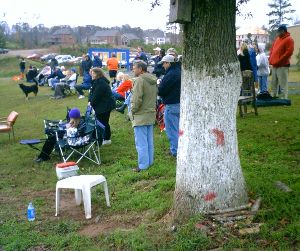Whitewash – Making

Q: Call me crazy, but I want to paint the trunks of some trees white for an upcoming party. I have seen trees out in the country that farmers painted white with whitewash. Where can I get whitewash or can I use something else?
A: Although whitewash was used for centuries to paint walls, fences and stonework, there are reasons it has fallen out of favor. To summarize in three words: It’s a mess!
One old recipe calls for mixing a half-barrel of quicklime* with water, twenty pounds of sugar and three pounds of zinc sulphate. Because quicklime* (see below) is so caustic, the process is not for the faint-of-heart.
Another says “For each gallon of water, dissolve 2 pounds of sodium chloride in it,and then slowly stir in 7 pounds of hydrated lime** (see below).
Yet another recipe says:
To make 2 gallons
* 5 lb hydrated lime** (see below)
* 6 pints water at room temperature
* 1 lb salt
* 1 pint warm water
In a large container, mix the lime with the room-temperature water and leave it overnight. The next day, mix the salt with the warm water and leave until dissolved. Add the salt water to the lime mixture and stir well. For coloring, add powdered pigment if desired. Store tightly covered.
*Quicklime (calcium oxide) is a white solid having a crystalline structure. Quicklime is highly reactive with water, generating considerable heat in the hydration process. It can be bought at masonry supply stores.
**Hydrated lime (calcium hydroxide) is a dry powder obtained by treating quicklime with sufficient water to satisfy its chemical affinity for water, thereby converting the oxides to hydroxides. It can be bought at garden centers.
Dr. Tom Crocker, Extension pecan specialist, says farmers now use plain old white latex paint to cover the lower part of their tree trunks. When the trees are young, the southwest side of the trunk becomes hot on sunny January days. When temperatures drop at night, unprotected bark will sometimes crack. The white paint prevents heat build-up and averts tree damage.


















